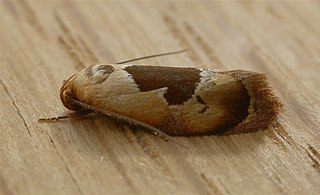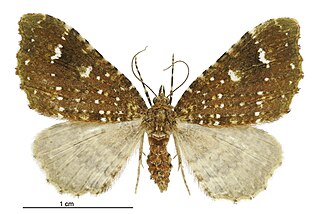| Hoplomorpha notatana | |
|---|---|
| Scientific classification | |
| Kingdom: | Animalia |
| Phylum: | Arthropoda |
| Class: | Insecta |
| Order: | Lepidoptera |
| Family: | Oecophoridae |
| Genus: | Hoplomorpha |
| Species: | H. notatana |
| Binomial name | |
| Hoplomorpha notatana (Walker, 1863) | |
| Synonyms | |
| |
Hoplomorpha notatana is a moth in the family Oecophoridae. It was described by Francis Walker in 1863. [1] It is found in Australia, where it has been recorded from Queensland. [2]

Moths comprise a group of insects related to butterflies, belonging to the order Lepidoptera. Most lepidopterans are moths, and there are thought to be approximately 160,000 species of moth, many of which have yet to be described. Most species of moth are nocturnal, but there are also crepuscular and diurnal species.

Oecophoridae is a family of small moths in the superfamily Gelechioidea. The phylogeny and systematics of gelechoid moths are still not fully resolved, and the circumscription of the Oecophoridae is strongly affected by this.

Francis Walker was an English entomologist. He was one of the most prolific authors in entomology, and stirred controversy during his later life as his publications resulted in a huge number of junior synonyms.
The wingspan is 19–25 mm. The forewings are whitish grey, irregularly suffused with dark-fuscous scales. The basal one-third of the costa, apex and upper half of the hindmargin are dark fuscous and there is a very large semicircular purplish-fuscous blotch extending on the inner-margin from one-fifth nearly to the anal angle reaching two-thirds across the disc, its anterior margin rounded, its posterior margin straighter, more oblique, and acutely angled just above the anal angle. There are also two small purplish-fuscous dots in the disc posterior to the summit of the dorsal blotch. The posterior portion of the disc is more or less suffused with fuscous, with a paler line first oblique, then parallel to the hindmargin. The hindwings are pale ochreous, the apex suffused with fuscous. [3]

The wingspan of a bird or an airplane is the distance from one wingtip to the other wingtip. For example, the Boeing 777-200 has a wingspan of 60.93 metres, and a wandering albatross caught in 1965 had a wingspan of 3.63 metres, the official record for a living bird. The term wingspan, more technically extent, is also used for other winged animals such as pterosaurs, bats, insects, etc., and other fixed-wing aircraft such as ornithopters. In humans, the term wingspan also refers to the arm span, which is distance between the length from one end of an individual's arms to the other when raised parallel to the ground at shoulder height at a 90º angle. Former professional basketball player Manute Bol stands at 7 ft 7 in (2.31 m) and owns one of the largest wingspans at 8 ft 6 in (2.59 m).






